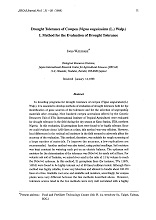In breeding programs for drought tolerance of cowpea (Vigna unguiculata (L.) Walp.), it is essential to develop methods of evaluation of drought tolerance both for the identification of gene sources of the tolerance and for the selection of segregating materials after crossing. Nine hundred cowpea accessions offered by the Genetic Resources Unit of IITA (International Institute of Tropical Agriculture) were evaluated for drought tolerance in the field during the dry season at Kano Station, IITA, northern Nigeria. In this evaluation, 22 germplasm lines were found to be highly tolerant. Since we could evaluate about 1,000 lines at a time, this method was very efficient. However, local differences in the residual soil moisture in the field seemed to adversely affect the accuracy of the evaluation. This method, therefore, was suitable for rough screening·of a large number of materials. To improve the accuracy, a few replications are recommended. Another method was also tested, using potted seedlings. Soil moisture was kept constant by watering each pot on an electric balance. The optimum soil moisture for the determination of the tolerance was 3%(w /w) for sandy soil at Kano. For volcanic ash soil at Tsukuba, we mixed river sand in the ratio of 1:1 by volume to reach the 3%(w/w) optimum. In this method, 21 germplasm lines (for instance, TVu 11979,14914) were found to be highly tolerant out of 90 lines/cultivars tested. Although this method was highly reliable, it was very laborious and allowed to handle about 100-170 lines at a time. Available root zone and available soil moisture, accordingly, for cowpea plants were very different between the two methods described above. However, tolerance scores rated in the two methods were very well correlated with a highly significant coefficient. Either of these two methods, therefore, can be adopted, depending on the objective of the evaluation.

